tags
annual black blossoms blue border bulb buttercup carpet climber cluster creeper cultivar daisy daisy-like edible endangered flower flowering fragrant genus rhododendron grassland hanging hedges and fences herb herbaceous and tree large blooms lila mauve Merry Christmas naturalising orange ornamenal pale yellow parrot peach perennial ph pink plants purple red rose salad green self-seeding showy shrub small florets soil spring spring to fall succulent temperate tree tri-colour blooms variegated weed white wildflower woody yellowMay 2024 M T W T F S S 1 2 3 4 5 6 7 8 9 10 11 12 13 14 15 16 17 18 19 20 21 22 23 24 25 26 27 28 29 30 31 -
Newly Added
- Merry Christmas
- Crassulaceae, – Hens and Chicks
- Succulent Plants
- Catalpa speciosa
- Salix Hakuro Nishiki
- Tropaeolum – Nasturtium
- Arugula
- Datura stramonium – Jimson Weed
- Taraxacum officinale – Dandelion
- Ranunculus – Buttercup etc.
- Gardenia
- Sweet Pea
- Lily – Lilium
- Flax – Perennial, Linum Perenne Lewsii
- Pinks – Dianthus
Blog Stats
- 12,770 hits
about this project
Realizing there is a need for an all encompassing gardener’s flora containing not just local but all varieties worldwide, cultivated or wild, this was set up to become just such a reference. Anyone who would like to take part and add in some entries of their favourite flora, or add to existing entires with additional facts or myths/beliefs is most welcome to do so. Just contact me by email and I’ll have you added as a contributor. Bear in mind photos do need to be your property to post them here. email: blogs@aletta.orgcomments
aletta mes on Narcissus aletta mes on Gazania – wildflower susan preston on Lysimachia nummularia ‘A… susan preston on Gazania – wildflower susan preston on Gazania – wildflower posts
- December 2014 (1)
- June 2014 (25)
- May 2013 (5)
- August 2010 (3)
- August 2008 (1)
- July 2008 (6)
- June 2008 (3)
my Flickr Photos
Category Archives: Uncategorized
A Poppy is a flowering plant in the subfamily Papaveroideae of the family Papaveraceae. Poppies are herbaceous plants, often grown for their colourful flowers. One species of poppy, Papaver somniferum produces edible seeds, and is also the source of the crude drug opium which contains powerful medicinal alkaloids such as morphine and has been used since ancient times as analgesic and narcotic medicinal and recreational drugs. Following the trench warfare which took place in the poppy fields of Flanders, during the 1st World War, red poppies have become a symbol of remembrance of soldiers who have died during wartime.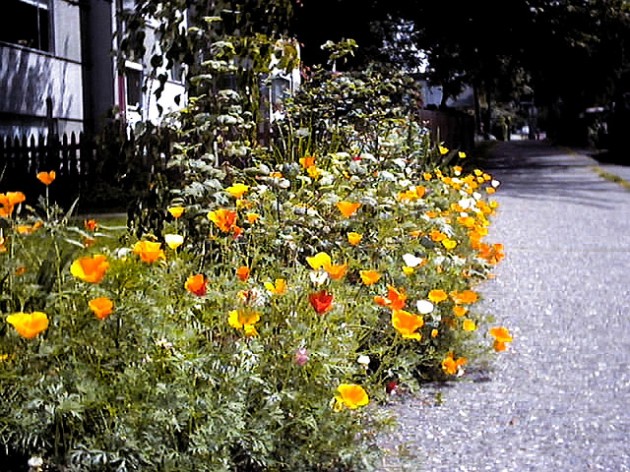
Description
Poppies are herbaceous annual, biennial or short-lived perennial plants. Some species are monocarpic, dying after flowering. Poppies can be over 4 feet tall with flowers up to six inches across. The flowers have 4 to 6 petals, many stamens forming a conspicuous whorl in the centre of the flower and an ovary consisting of from 2 to many fused carpels. The petals are showy, may be of almost any color and some have markings. The petals are crumpled in the bud and as blooming finishes, the petals often lie flat before falling away. Poppies are in full bloom late spring to early summer.[1] Most species secrete latex when injured. Bees use poppies as a pollen source. The pollen of the oriental poppy, Papaver orientale, is dark blue, that of the field or corn poppy (Papaver rhoeas) is dark green to grey.[2] The opium poppy, Papaver somniferum, is mainly grown in eastern and southern Asia, and South Eastern Europe. It is believed that it originated in the Mediterranean region [3]
Poppies belong to the subfamily Papaveroideae of the family Papaveraceae, which includes the following genera:
- Papaver – Papaver rhoeas, Papaver somniferum, Papaver orientale, Papaver nudicaule
- Eschscholzia – Eschscholzia californica
- Meconopsis – Meconopsis cambrica, Meconopsis napaulensis
- Stylophorum – celandine poppy
- Argemone – prickly poppy
- Romneya – matilija poppy and relatives
- Canbya – pygmy poppy
- Stylomecon – wind poppy
- Arctomecon – desert bearpaw poppy
- Hunnemannia – tulip poppy
- Dendromecon – tree poppy
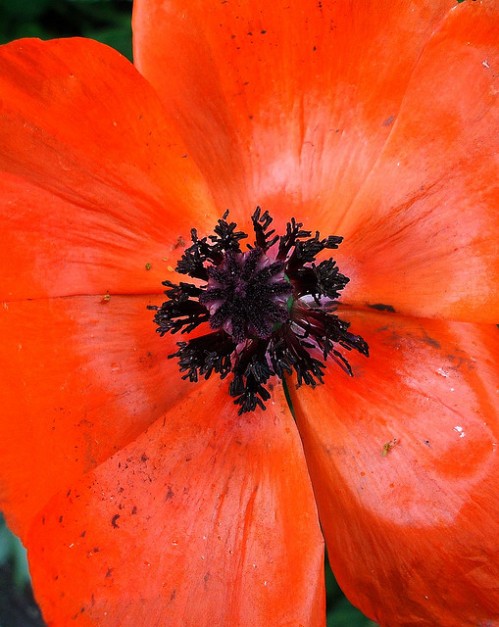 Uses
Uses
The flowers of most poppy species are attractive and are widely cultivated as annual or perennial ornamental plants. This has resulted in a number of commercially important cultivars, such as the Shirley poppy, a cultivar of Papaver rhoeas and semi-double or double (flore plena) forms of the opium poppy Papaver somniferum and oriental poppy (Papaver orientale). Poppies of several other genera are also cultivated in gardens. A few species have other uses, principally as sources of drugs and foods. The opium poppy is widely cultivated and its worldwide production is monitored by international agencies. It is used for production of dried latex and opium, the principal precursor of narcotic and analgesic opiates such as morphine, heroin and codeine. Poppy seeds are rich in oil, carbohydrates, calcium, and protein. Poppy oil is often used as cooking oil, salad dressing oil, or in products such as margarine. Poppy oil can also be added to spices for cakes, or breads. Poppy products are also used in different paints, varnishes, and some cosmetics (Jonsson and Krzymanski, 1989).
Symbolism
Poppies have long been used as a symbol of sleep, peace, and death: Sleep because of the opium extracted from them, and death because of the common blood-red color of the red poppy in particular. In Greek and Roman myths, poppies were used as offerings to the dead.[4] Poppies used as emblems on tombstones symbolize eternal sleep. This symbolism was evoked in the children’s novel The Wonderful Wizard of Oz, in which a magical poppy field threatened to make the protagonists sleep forever.[4]
A second interpretation of poppies in Classical mythology is that the bright scarlet colour signifies a promise of resurrection after death.[5]
The poppy of wartime remembrance is Papaver rhoeas, the red-flowered corn poppy. This poppy is a common weed in Europe and is found in many locations; including Flanders, which is the setting of the famous poem “In Flanders Fields,” by the Canadian surgeon and soldier John McCrae. In Canada, the United Kingdom, Australia, South Africa and New Zealand, artificial poppies (plastic in Canada, paper in the UK, Australia, South Africa, Malta and New Zealand) are worn to commemorate those who died in war. This form of commemoration is associated with Remembrance Day, which falls on November 11. In Canada, Australia and the UK, poppies are often worn from the beginning of November through to the 11th, or Remembrance Sunday if that falls on a later date. In New Zealand and Australia, soldiers are commemorated on ANZAC day (April 25),[6] although the poppy is still commonly worn around Remembrance Day. Wearing of poppies has been a custom since 1924 in the United States. Miss Moina Michael of Georgia is credited as the founder of the Memorial Poppy in the United States.[7][8][9]
Medical uses
Ancient Egyptian doctors would have their patients eat seeds from a poppy to relieve pain. Poppy seeds contain small quantities of both morphine and codeine,[10] which are pain-relieving drugs that are still used today. Poppy seeds and fixed oils can also be nonnarcotic because when they are harvested the morphine practically disappears from the seeds twenty days after the flower has opened (Jonsson and Krzymanski, 1989).
Other uses
The California poppy, Eschscholzia californica, is the state flower of California.
In Mexico, Grupo Modelo, the makers of Corona beer, used red poppy flowers in most of its advertising images until the 1960s.
A poppy flower is depicted on the reverse of the Macedonian 500 denars banknote, issued in 1996 and 2003.[11] The poppy is also part of the coat of arms of the Republic of Macedonia.
The powerful symbolism of Papaver rhoeas has been borrowed by various advocacy campaigns, such as the White Poppy and Simon Topping‘s black poppy.
The girl’s given name “Poppy” is taken from the name of the flower.[citation needed]
Poppies (called amapolas in Spanish) are commonly featured as the central flower in Puerto Rican weddings.[citation needed]
Artificial poppies (called “Buddy Poppies”) are used in the veterans’ aid campaign by the Veterans of Foreign Wars, which provides money to the veterans who assemble the poppies and various aid programs to veterans and their families.[12]
Canada issued special quarters (25-cent coins) with a red poppy on the reverse in 2004, 2008 and 2010. The 2004 Canadian “poppy” quarter was the world’s first coloured circulation coin.[13]
Forget-me-not refers to the plants of the genus Myosotis. This genus comes under the family Boraginaceae. There are roughly 50 species within this genus. There exists variation within the genus. However, one similarity that can be noticed is that most of the members of this species have flat blue flowers with five petals growing thickly on stems. They grow in a slightly disorderly fashion.
A legend about the origin of the name forget-me-not is as follows. Once a medieval knight and his lady-love were walking beside a river. The knight held a bouquet in his hands. Because of the weight of the armor, he fell into the water. According to the legend, he threw the bouquet at her shouting forget-me-not. There is a Christian religious legend according to which the child Jesus Christ created forget-me-nots so that the generations to come would be able to see him and his mother Mary, on whose lap he was sitting.
Scientific Classification
- Kingdom
- Plantae
- Division
- Magnoliophyta
- Class
- Magnoliopsida
- Order
- not currently assigned (incertae sedis)
- Family
- Boraginaceae
- Genus
- Myosotis
Facts about forget-me-not
- Forget-me-nots flower in spring.
- A large number of species that come under the forget-me-not category are native to New Zealand.
- A few European Species were introduced in the temperate regions of America, Asia, and Europe.
- Forget-me-not is the state flower of the American state of Alaska.
- Forget me not plants can be annual, in the sense that their life last for one year or it can be perennial, in the sense that their life – namely, germination, flowering, and death take more than two years.
How to Grow Forget-Me-Not
- Plant the seeds in early spring. The ground should be made ready for the forget me not seeds to be planted.
- The preparation should be done by mixing the soil with decomposed organic material (compost) because the plants grow best in such soil.
- While planting seedlings, you do not have to be particularly careful about maintaining some distance between them because forget me nots grow well even if there is a crowd.
- Trim the blooms that are wasted away in order to guard against reseeding.
- When plants begin to wear away in late summer, remove them.
Aside from Roses, there is no flower as beautiful and aromatic as Lilacs. Of the two, Lilacs have a stronger scent that carries quite a distance. Unfortunately, Lilacs bloom for only a very brief couple of weeks in the spring. To prolong their presence in your yard, grow a variety of Lilacs, including, early, mid and late varieties. With variety and luck, you may be able to see Lilacs in bloom in your yard for up to six weeks. Weather will have a lot to do with how long your blooms last. Once the buds begin to open, pray for a cool dry spell. Once the blooms are over, you still have a nice shade bush, but you have to wait for up to fifty more weeks to see them again.
- History
- Lilacs in the United States date back to the mid 1750’s. They were grown in America’s first botanical gardens and were popular in New England. Both George Washington and Thomas Jefferson grew them in their gardens. Lilac bushes can live for hundreds of years, so a bush planted at that time may still be around. Lilacs originated from Europe and Asia, with the majority of natural varieties coming from Asia. In Europe, lilacs came from the Balkans, France and Turkey.
- Where is
- the Lilac Capital of the World? Many areas grow them and many have a wide variety in large numbers. But Rochester, N.Y. undoubtedly is the Lilac Capital of the World. It’s love for Lilacs dates back to 1892 when Highland Park horticulturalist John Dunbar planted 20 varieties on the sunny southern slopes of the park. Highland Park in Rochester is the scene of an annual, two week long Lilac Festival ,with over a half a million people attending the event each year. This park has over 500 varieties of lilacs and more than 1200 lilac bushes in the parks’ 155 acres.In addition, many homes and parks in the Rochester area have one or more lilac bushes. If you take a ride along many of the Finger Lakes, you will find thousands of them along the roadside and the sweet smell will come right through your open window.
Cornwall in Ontario, Canada boasts the “City of Lilacs” and rivals Rochester,NY in size of their collection.
Rochester, New Hampshire also calls themselves the “Lilac City”. Lilacs are the state flower.
Did You Know?
There are over 1,000 varieties of Lilacs. They come in several colours, with the most popular being the colour lilac and purple. White and pink are also popular. They also vary widely in size from the small 4 to 8 feet to types those growing up to 30 feet. So there is a variety perfect for your needs.
– Orange Hawkweed
– Devil’s Paintbrush
(H. aurantiacum)
Family: Asteraceae

Although considered a pernicious weed, the bright orange blooms along paths and roadways are breathtaking. I’ve personally transplanted a few to planters on my balcony. They thrive, blooming more than once, if given good fertilizer, right after a blooming is done.
Blackish hairs on the bracts around flower heads and elsewhere were so reminiscent of coal in their blackishness, that herbalists in the sixteenth century called it Grim the Collier.
Flowers and flower-heads
Hieracium or hawkweeds, like others in the Asteraceae family, have mostly yellow,[11] tightly packed flower-heads of numerous small flowers[8] but, unlike daisies and sunflowers in the same family, they have not two kinds of florets but only strap-shaped (spatulate) florets, each one of which is a complete flower in itself, not lacking stamens,[11] and joined to the stem by leafy bracts. As in other members of the tribe Cichorieae, each ray corolla is tipped by 3 to 5 teeth.[8]
Bracts, stems and leaves
Erect single, glabrous or hairy stems, sometimes branched away from the point of attachment, sometimes branched throughout.
The hairiness of hawkweeds can be very complex: from surfaces with scattered to crowded, tapered, whiplike, straight or curly, smooth to setae; “stellate-pubescent” or surfaces with scattered to crowded, dendritically branched (often called, but seldom truly, “stellate”) hairs; and “stipitate–glandular” or surfaces with scattered to crowded gland-tipped hairs mostly. Surfaces of stems, leaves, peduncles, and phyllaries may be glabrous or may bear one, two, or all three of the types of hairs mentioned above.[12]
Like the other members of the Chicory tribe, hawkweeds contain a milky latex.[11]
Ecology
The Large Yellow Underwing (Noctua pronuba) feeds on Hieracium species.
Distribution
Hieracium species are native to Africa,[12]Asia, Europe, North America,[13] Central America and South America.
Species
Main article: List of Hieracium species
The classification of Hieracium into species is notoriously difficult. One reason is the apomictic reproduction (in which plants asexually produce seeds), which tends to produce a lot of minor geographical variation. Over 9000 species names have been published in Hieracium but some botanists regard many of those as synonyms of larger species.[12]
Europe
- Hieracium lucidum Guss. – Sicilian Sparviere
- Hieracium insolitum (Zahn) Üksip
- Hieracium villosum Jacq.
North America
The list below is a selection of species that have been accepted by the USDA Natural Resources Conservation Service[1] and Canada.[14] A more complete list is given in the list of Hieracium species.
- Hieracium albiflorum Hook. – white hawkweed
- Hieracium × alleghaniense Britt. (pro sp.)
- Hieracium argutum Nutt. – southern hawkweed
- Hieracium × atramentarium (Naegeli & Peter) Zahn ex Engl. (pro sp.)
- Hieracium atratum Fries – polar hawkweed
- Hieracium aurantiacum L. – orange hawkweed
- Hieracium bolanderi Gray – Bolander’s hawkweed
- Hieracium × brachiatum Berth. ex DC.
- Hieracium caespitosum Dumort. – meadow hawkweed
- Hieracium canadense Michx. – Canada hawkweed
- Hieracium carneum Greene – Huachuca hawkweed
- Hieracium cynoglossoides Arv.-Touv. – houndstongue hawkweed
- Hieracium × fassettii Lepage
- Hieracium fendleri Schultz-Bip. – yellow hawkweed
- Hieracium × fernaldii Lepage
- Hieracium flagellare Willd. – whiplash hawkweed
- Hieracium floribundum Wimmer & Grab. – kingdevil hawkweed
- Hieracium × fuscatrum Naegeli & Peter (pro sp.)
- Hieracium glomeratum Froel. – queen-devil hawkweed
- Hieracium gracile Hook. – slender hawkweed
- Hieracium greenei Gray – Greene’s hawkweed
- Hieracium greenii Porter & Britt. – Maryland hawkweed
- Hieracium × grohii Lepage
- Hieracium gronovii L. – queendevil
- Hieracium horridum Fries – prickly hawkweed
- Hieracium kalmii L. – Kalm’s hawkweed
- Hieracium lachenalii K.C. Gmel. – common hawkweed
- Hieracium lactucella Wallr. – European hawkweed
- Hieracium laevigatum Willd. – smooth hawkweed
- Hieracium lemmonii Gray – Lemmon’s hawkweed
- Hieracium longiberbe T.J. Howell – longbeard hawkweed
- Hieracium longipilum Torr. – hairy hawkweed
- Hieracium maculatum Sm. – spotted hawkweed
- Hieracium marianum Willd. – Maryland hawkweed
- Hieracium megacephalon Nash – coastal plain hawkweed
- Hieracium murorum L. – wall hawkweed
- Hieracium paniculatum L. – Allegheny hawkweed
- Hieracium parryi Zahn in H.G.A. Engler – Parry hawkweed
- Hieracium pilosella L. – mouseear hawkweed
- Hieracium piloselloides Vill. – tall hawkweed
- Hieracium praealtum Vill. ex Gochnat – kingdevil
- Hieracium pringlei Gray – Pringle’s hawkweed
- Hieracium robinsonii (Zahn) Fern. – Robinson’s hawkweed
- Hieracium rusbyi Greene – Rusby’s hawkweed
- Hieracium sabaudum L. – New England hawkweed
- Hieracium scabrum Michx. – rough hawkweed
- Hieracium schultzii Fries – roughstem hawkweed
- Hieracium scouleri Hook. – Scouler’s woollyweed
- Hieracium scribneri Small – Scribner’s hawkweed
- Hieracium triste Willd. ex Spreng. – woolly hawkweed
- Hieracium umbellatum L. – narrowleaf hawkweed
- Hieracium venosum L. – rattlesnakeweed
Plant pest
All species of the genus Hieracium are classed as invasive species throughout New Zealand. They are banned from sale, propagation and distribution under the National Pest Plant Accord. Hieracium is a pasture weed that reduces available feed for livestock and displaces the indigenous plants.[15] It is a particular threat in alpine ecosystems previously dominated by native tussocks, though it will colonise habitats from bare ground, to exotic pine forest, to native Southern Beech forest.[16]
In the United States, many species of Hieracium have been introduced and all species present are considered noxious weeds in one or more states.[17]


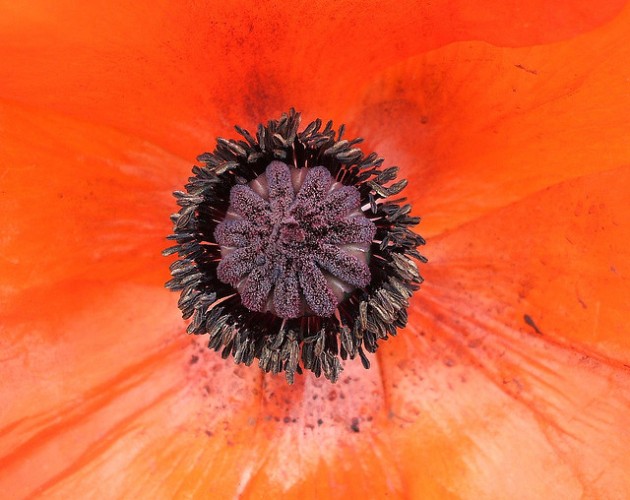
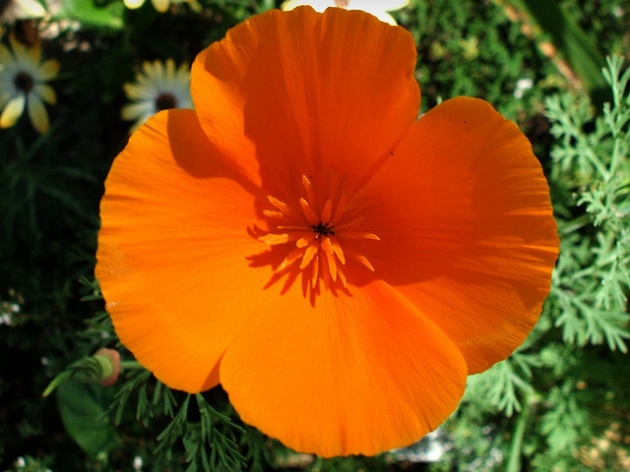
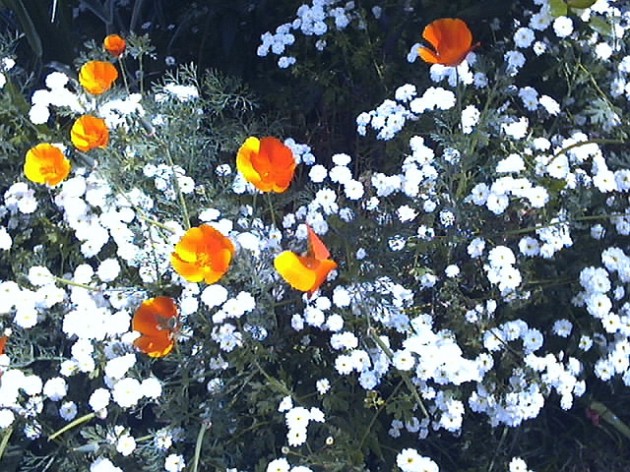
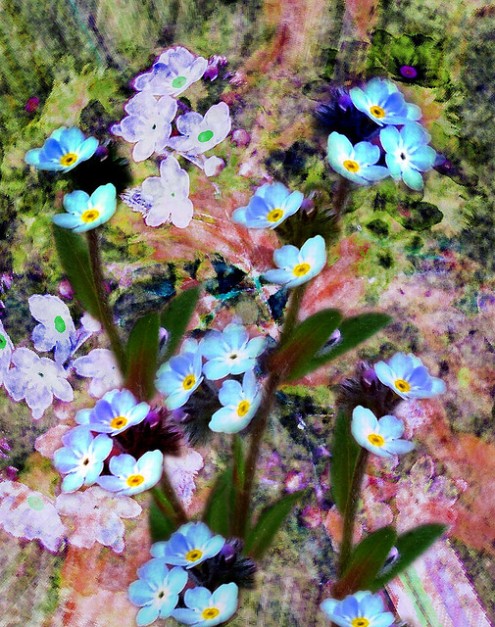
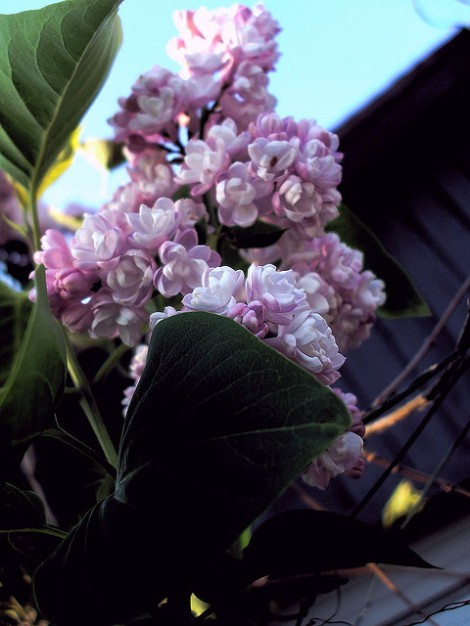
![20170123050651-f09370cbed.[gif-2-mp4.com] 20170123050651-f09370cbed.[gif-2-mp4.com]](https://live.staticflickr.com/428/32472212275_9af8805d25_m.jpg)


